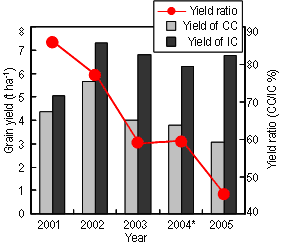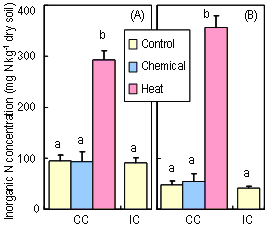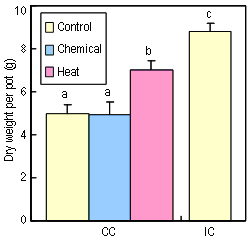Abiotic factors cause gradual yield decline under continuous aerobic rice cultivation
Description
The aerobic rice (AR) water-saving system, characterized by non-puddling, aerobic soil conditions and higher yield as compared to the conventional upland rice system, has been developed under the leadership of the International Rice Research Institute (IRRI). However, an underlying risk in continuous cropping which leads to gradual yield decline has been a major obstacle for dissemination. To cope with this, it has been examined mainly from the angles of disease and insect damages, but other cases that can not be explained only from these viewpoints have been observed. The phenomenon of the gradual yield decline was also found at field plots of the IRRI Farm where AR has been cultivated continuously for 10 cropping seasons and it did not appear to be due to any damage caused by diseases and insect pests. But it was unclear whether there existed significant abiotic factors in the phenomenon. Hence, we hypothesized that there existed abiotic factors causing the continuous cropping yield decline risk and examined the hypothesis through a pot experiment using the continuous AR cultivated soil from IRRI.
From field plots under the following two treatments, where only the water management had been modified for 10 cropping seasons since 2001, 0.2 m-deep undisturbed top soils were collected with PVC tubes (0.2-m i.d.). “Continuous cultivation” (CC): continuous AR-cultivation where the gradual yield decline (Fig. 1) was observed (with 50-mm irrigation when soil water tension at 0.15 m-deep soil dropped to -30 kPa during the cropping season, most especially higher to -10 kPa during the flowering period); “Incontinuous cultivation” (IC): incontinuous AR-cultivation where yield decline was not observed (a continuous flooding treatment during cropping seasons except those in year 2004). Immediately after soil collection, the PVC tubes were directly processed into cultivation pots, and then the soils received the following two treatment's ‘Heat treatment’ (HT): a 24-h heat treatment under 95-98 °C; ‘Chemical treatment’ (CT): applied 3 and 1 mg carbofuran (a nematocide) and benomyl (a fungicide) per pot 7-day after transplanting (DAT), respectively. Three 14-day-old Apo seedlings were transplanted into the center of each pot and cultivated under the same AR cultivation environment (kept flooding for 12 DAT and 450-ml irrigation per pot every four days on and after 21 DAT; applied N, P, K and Zn at a rate of 157, 188, 126 and 16 mg per pot at -1 DAT, respectively, and N at a rate of 157 mg per pot at 33 DAT). All were performed with four replications. In terms of major soil properties (pH, organic C, total N, Olsen P, exchangeable K, CEC and texture), no significant difference (P < 0.05) was observed between the two soils at the beginning of both the field experiment and this pot experiment, except pH (7.1 + 0.0 and 6.8 + 0.2 (mean + SD) at CC and IC, respectively) and Olsen P (29.7 + 1.5 and 24.0 + 1.0 mg kg-1 at CC and IC, respectively) found at the beginning of this pot experiment. No disadvantage for plant growth was found in the soil-water conditions and inorganic N contents (Fig. 2) of the CC pot soils. At HT-CC, rice growth was promoted by the heat treatment due to the increase in the supply of nutrients such as inorganic N (Fig. 2), but it was significantly at a lower level as compared with that of non-treated IC (Fig. 3). The effect of CT, which is commonly considered effective against nematode and fungi, was also not significant (Fig. 3). Hence, we concluded that some unidentified soil-borne abiotic factors affected the yield decline observed under the AR continuous cropping system.
It was indicated that studies from the viewpoint of healthy soil management are necessary for the practical use of AR. We can not deny the possibility of deficiency of other minerals apart from some micronutrients (Ca, Mg, Mo, B, Zn, Cu, Fe), P and K, that have been examined at IRRI, some mechanism that retards the uptake of N existing in the soil, and/or the effect of changes in soil physical properties, etc. A breakthrough in the dissemination of the AR System may be made possible if we can identify the abiotic factors and develop clear countermeasures using observed phenomena, such that it will lead to the sustainable yield of continuous AR cultivation plots partly restored with the insertion of appropriate submergence field management.
Figure, table
-
Fig. 1. Yield decline phenomenon observed at continuous aerobic rice (AR) cultivation plots (CC), IRRI.
CC: continuous AR cropping; IC: incontinuous AR cropping with continuous flooding management except year 2004* when both dry season (DS) and wet season (WS) croppings were managed under aerobic rice conditions. Each bar indicates the mean value (n = 4) of a DS cropping. This field experiment had been performed since the DS 2001 and the soils for the pot experiment were collected at the harvest time of the WS 2005 after 10-season cropping with double rice cropping a year. -
Fig. 2. Inorganic N concentration (ammonium N and nitrate N) in pot soils 17 (A) and 47 (B) days after transplanting.
Control: no treatment; Chemical; applied 3 and 1 mg carbofuran and benomyl, respectively, per pot 7 days after transplanting; Heat: a 24-h heat treatment under 95-98 ºC; CC: soil from a continuous aerobic rice (AR) cropping field; IC: soil from an incontinuous AR cropping field. Error bars indicate SEs (n = 4). Means followed by a different letter are significantly different at P < 0.05 (LSD test). -
Fig. 3. Aboveground biomass observed 47 days after transplanting (at a panicle initiation stage).
Error bars indicate SEs (n = 4). Means followed by a different letter are significantly different at P < 0.05 (LSD test). For abbreviations, see Fig 2.
- Affiliation
-
Japan International Research Center for Agricultural Sciences Crop Production and Environment Division
-
International Rice Research Institute
Yamagata University
- Classification
-
Technical A
- Term of research
-
FY2008(FY2005~2010)
- Responsible researcher
-
SASAKI Yuka ( International Rice Research Institute )
HOSEN Yasukazu ( Crop Production and Environment Division )
- ほか
- Publication, etc.
-
Sasaki, Y., Hosen, Y., Peng, S., Nie, L., Rodriguez, R., Agbisit, R. Fernandez, L., Bouman, B.A.M. and Kobayashi, N. (2006) Possibility of abiotic factors in a gradual yield decline under a continuous aerobic rice cropping system. Abstracts of the annual meeting, Japanese Society of Soil Science and Plant Nutrition 52, 116.
Sasaki, Y., Hosen, Y., Peng, S., Nie, L., Rodriguez, R., Agbisit, R., Fernandez, L. and Bouman, B.A.M. (submitted): Do abiotic factors cause a gradual yield decline under continuous aerobic rice cultivation?. Soil Science and Plant Nutrition
- Japanese PDF
-
2008_seikajouhou_A4_ja_Part13.pdf494.87 KB



